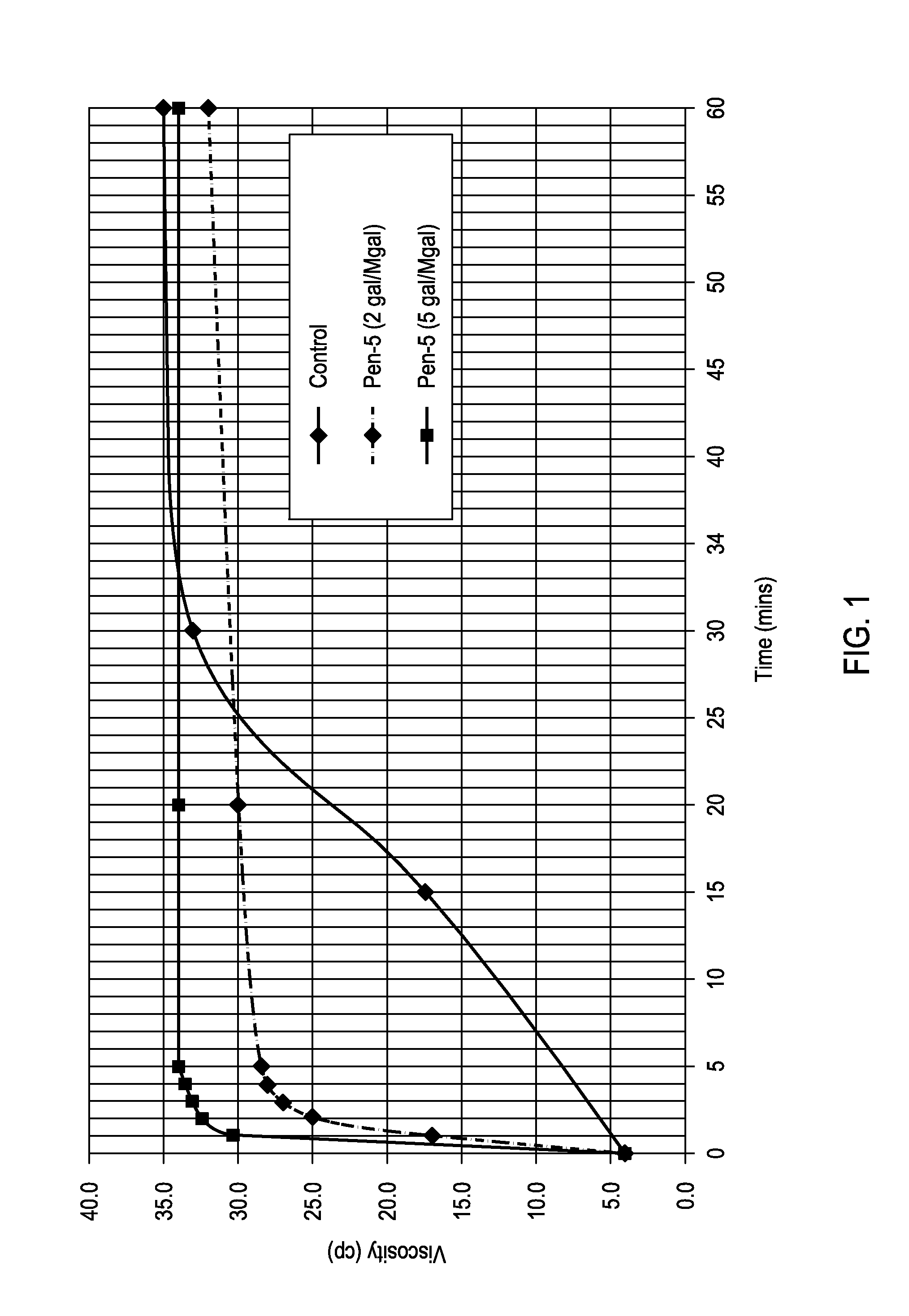Hydration Acceleration Surfactants in Conjunction with High Molecular Weight Polymers, and Methods and Compositions Relating Thereto
a technology of surfactants and molecular weight polymers, applied in the field of hydrostatic acceleration surfactants, can solve the problems of increasing the cost and logistical burden of an operation, affecting the dissolution efficiency of high molecular weight polymer dissolution efforts, and affecting the dissolution efficiency of high molecular weight polymer, etc., to achieve the effect of reducing formation permeability, reducing formation permeability, and controlling water production
- Summary
- Abstract
- Description
- Claims
- Application Information
AI Technical Summary
Benefits of technology
Problems solved by technology
Method used
Image
Examples
example 1
[0051]Three treatment fluids were prepared according to the concentrations listed in Table 1 utilizing water containing 2% KCl, a hydration acceleration surfactant of PEN-5® (an aqueous solution of C12-C14 ethoxylated alcohol with 11 moles of ethylene oxide and an HLB of 14, available from Halliburton Energy Services, Inc.), and a polymeric emulsion comprising a base polymer of ALCOMER® A90L (polyacrylamide with a molecular weight of greater than about 11,000,000 and a degree of hydrolysis less than about 8%, available from BASF). The amount of polymer in the treatment fluid was maintained at 0.72% by weight of the fluid.
TABLE 1ControlSample 1Sample 2PEN-5 ®0 2 gal / Mgal 5 gal / MgalALCOMER ® A90L15 gal / Mgal15 gal / Mgal15 gal / Mgal(0.72% polymer)
[0052]The viscosity of the treatment fluid was measured over time and is reported in FIG. 1, which illustrates the polymer hydration time (i.e., the time for the viscosity of the treatment fluid to stabilize) for the control of about 35 minutes, ...
example 2
[0054]To a fresh batch of Sample 2 described in Example 1, 13 gal / Mgal HZ-20™ crosslinker polymer was added along with a solution of an additive GEL-STA™ (an inorganic salt, available from Halliburton Energy Service, Inc.) that may prevent polymer degradation at elevated temperature. The base polymer to crosslinker ratio for this formulation was 1.0:0.54. The solution was divided into two batches. To one batch, two concentrations of a gel time retarder K-35™ (a carbonate salt, available from Halliburton Energy Service, Inc.) designed to extend the crosslinker time at a given temperature were added as shown in Table 2, and the crosslinking times (gel times) were measured at different temperatures as shown Table 2.
TABLE 2TemperatureK-35 ™K-35 ™Sample(° F.)(5 lb / Mgal)(15 lb / Mgal)118571521954832053742152.5652251.53.5
[0055]The results in Table 2 demonstrate that crosslinked compositions can be formed using methods that involve hydration of polymer emulsions in the presence of hydration a...
example 3
[0056]Permeability reduction experiments were performed using a core flow study at 180° F. in which a sand pack prepared with 20 / 40 sand was used as the core. The treatment fluid described in Example 2 without the retarder was introduced into the sand pack, and a sufficient amount of time was allowed for the crosslinking reactions to take place. Then, the resistance to fluid flow through the treated sand pack was measured by pumping a 2% KCl solution through the treated sand pack. The results showed that the permeability of the treated sand pack to 2% KCl solution was reduced by 100%. Similar results were obtained by treating a sand pack prepared with graded 16 / 20 calcium carbonate particle at a temperature of 225° F.
[0057]This example illustrates that the treatment fluid described herein may, in some embodiments, be suitable for use in bridging a fracture, reducing or blocking formation permeability to fluid flow, providing fluid loss control, sealing a rock surface for fluid diver...
PUM
| Property | Measurement | Unit |
|---|---|---|
| temperature | aaaaa | aaaaa |
| temperature | aaaaa | aaaaa |
| temperature | aaaaa | aaaaa |
Abstract
Description
Claims
Application Information
 Login to View More
Login to View More - R&D
- Intellectual Property
- Life Sciences
- Materials
- Tech Scout
- Unparalleled Data Quality
- Higher Quality Content
- 60% Fewer Hallucinations
Browse by: Latest US Patents, China's latest patents, Technical Efficacy Thesaurus, Application Domain, Technology Topic, Popular Technical Reports.
© 2025 PatSnap. All rights reserved.Legal|Privacy policy|Modern Slavery Act Transparency Statement|Sitemap|About US| Contact US: help@patsnap.com

